This article covers permitting and directly related design issues associated with thermal processes used for drying and calcining, using the production of ceramic proppants as an illustrative example. While the magnitude of permitting issues varies significantly with air-quality attainment area status, oxides of nitrogen (NOx), carbon monoxide and particulate matter are always the major issues. With proper design and operation, these emissions can be controlled at a reasonable cost.
What are proppants?
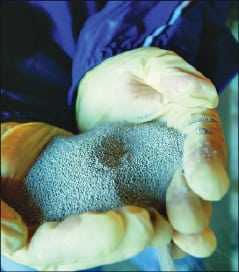 |
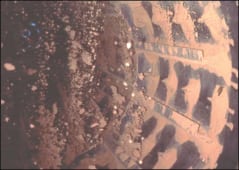 |
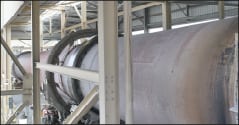 |
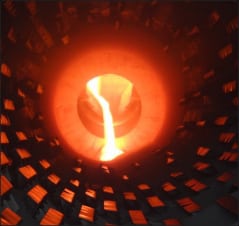 |
The shale gas gold rush is underway in multiple states throughout the U.S. A critical ingredient that has made shale gas possible are proppants, which are materials used to prop open the fissures in the wells created by hydraulic fracturing. Permitting and related equipment selection are a critical items constraining supply of this important raw material.
Well-bore proppants are made from specially sized and chosen sand, or from ceramic beads (Figure 1) made in a high-temperature process from kaolin and other minerals. The proppant works much like the timber shoring used in old shaft mines to support the roof and walls, but in this case, the shoring is being done on a micro scale.
There is a hierarchy for proppants, with the ceramic type having the highest conductivity, ultimate gas recovery, and gas production rates. This is due to superior sphericity, high crush strengths and lower settling rates as compared to uncoated frac sand. Next come resin coated sand, then uncoated frac sand. The producers selling point for uncoated frac sand is lower initial cost and potential for local supply. More on the trade offs of the competing types can be had in the production-related trade journals [1].
Dryers and kins
Dryers are used to dry and de-agglomerate sand for screen sizing, while high-temperature kilns are required to calcine and harden the ceramic proppants.
Sand drying is done in either a rotary dryer (Figure 2) or fluidized-bed dryers. A temperature of 250°F yields a product suitable for screening. It would be tempting to say that such a low-temperature process will produce little NOx from the required burners, but while process gas and solid product are low in temperature, fuel economy dictates relatively low excess air in the burner system, which in turn results in higher flame temperatures and NOx concentrations.
Production of ceramic proppants takes much higher temperatures and is done in refractory lined kilns (Figure 3). These temperatures are in the range of that of cement manufacture, with rotary coolers (similar to those used in cement kilns; Figure 4) used to cool the product. This also preheat combustion air to almost 2,000°F. Such high air-preheat temperatures reduce fuel use, but also exponentially increase NOx concentrations.
Emissions and regulations
In brief, the regulatory issues are NOx, CO and particulate emissions, in decreasing order of importance. Natural gas and propane are the predominant fuels, but if fuel oil is used, SO2 may also come into play.
A big issue is location of a facility. Permitting — and operating — is easier in air quality attainment areas as designated by national ambient-air-quality standards (NAAQS). If the plant must be located in a non-attainment area for ozone (NOx is a precursor for ozone), additional controls and cost may result. If this is an expansion of an existing facility, the existing Title V permit will have to be updated. In some cases, taking a voluntary annual operating-hour limit to cap the tons per year of a particular emission may be instrumental in keeping capital and operating costs in line. In short, given higher constraints, it is unlikely that a facility of significant size would choose to site itself in an ozone non-attainment area.
Additionally, the magnitude of the emissions may trigger New Source Review (NSR) permitting, an expensive and lengthy exercise, which may require post-combustion controls or acquire internal or external emission offsets (or both) in order to permit the modification. Alternately, it may be wise for a given location to cut capacity during design to a level that will not trigger NSR.
The U.S. Environmental Protection Agency’s (EPA; Washington, D.C.) AP-42 Compilation of Air Pollutant Emission Factors [2] is a frequently used resource in producing the permit application. For the current hot market of proppants produced via frac sand dryers and ceramic proppant kilns, the minerals industries subsection (AP-42 Chapter 11) can prove useful in writing permit applications. While AP-42 is updated from time to time, advances in low NOx burners may not have been captured in the emissions factors, so judiciously applied (and proven by stack test) vendor data is also a good resource. Similarly, AP-42 may not have a process similar enough to the high temperature kilns for ceramic proppants, and input from similar process stack tests may be of importance.
Best practices for compliance
The author has worked on reducing emissions on rotary dryers and kilns used for proppant manufacture, on limiting NOx from firing of fluidized-bed dryers, and controlling VOC (volatile organic compound) emissions from a proppant resin-coating operation. Major tools involved in fixing the problem follow for specific applications. A general one to add here is stack height. It is not unusual for regulators to require a dispersion model, and short stacks become a great disadvantage when dispersion models are applied. We suggest that 75 ft (23 m) should be considered an absolute-minimum stack height if there is a chance that such modeling might be required in the future.
Particulate matter control
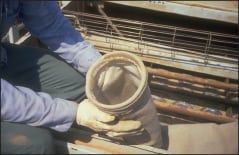 |
To address the easiest issue first, baghouses are used for the control of particulate matter. Unless a state agency sets an unreasonably low limit, a good baghouse (see Figure 5) and good bag filters take care of the issue for both dryer and kiln applications. Other sources, such as conveyor transfer points, may get added into the total particulate matter for the site.
NOx control
For new rotary dryers, the simple choice is to use a closed-in burner that is of a low NOx design.
Fluidized-bed dryers use a variety of pressurized burners to supply hot gas to the fluidizing grid. New generation line burners are one fix, with vendors offering a guarantee of less than 30 parts per million (ppm) NOx at 3 vol.% O2, much lower than older designs.
For high-temperature kilns, the authors employer has used some of its tried and true combustion-modification techniques, those being low oxygen firing coupled with a limited amount of water injection into the combustion zone. These modifications have resulted in over 50% reduction in tons per year of NOx emissions, and seven-figure-dollar annual fuel savings.
NOx guarantees are thin for the kiln-style preheated air burners. And, with about 90% of the air coming through the rotary product cooler/air preheater and only 10% through the burner, and the ultra-high combustion temperatures and long residence time in the hot zone of the kiln, equilibrium effects may well overshadow any abilities of a burner to control NOx.
Can end-of-pipe controls be added to reduce NOx? To the authors knowledge, neither selective catalytic reduction nor nonselective catalytic reduction have been applied to proppant manufacture in the U.S. They would add significant capital and operating cost, may require preheating the gas after it leaves the baghouse, and there is always a risk that catalysts may fail due to small amounts of poisoning or fouling agents in the process feedstock. The SCR solution has not-so-green side effects, such as adding to fuel use and emissions for reheat, adding to power requirements for higher pressure drop (which result in utility based emissions), and manufacture and transport of ammonia and similar reagents, which have safety concerns.
Are there other alternatives? While to the authors knowledge, they have not been applied to ceramic proppant production, some work has been done on staged fuel rich/lean combustion in cement kilns (with rich firing at the burner, with a zero oxygen in the combustion products, then more air added further down the kiln to complete combustion, but at a lower temperature, with lower expected NOx concentrations). Cement kiln results have claimed NOx reductions of 11 to 55% [3].
CO control
CO and NOx are linked though the combustion process. For example, if low O2 firing is used to reduce NOx by operating close to the stoichiometric ratio (zero percent excess air), cutting O2 too far will result in a spike of CO. CO varies with fuel, with propane being about 25% higher on some burners than on natural gas, and it being higher yet for No. 2 fuel oil.
A wild card for CO (and VOCs) is the existence of kerogens in the feedstock. This is a site-specific issue, as they are naturally occurring organics (for instance, peat), which when heated devolatilize and give off VOCs and may also contribute to CO emissions.
Resin coated sand
An issue of smaller magnitude are the emissions from resin coating of sand. The primary issue is organic vapors, with RTOs (regenerative thermal oxidizers) being the usual fix, with typical permitting goals of reaching >95% VOC destruction.
Final remarks
Manufacturers that want to add dryer or kiln capacity (in particular, for the hot market of proppant supply) must make significant decisions early on when siting and permitting the facilities to allow fast implementation. Choosing the right combustion and air-pollution-control equipment is critical to minimizing NOx, CO and particulate emissions, and maximizing the potential production at a given site.
References
1. Percival, Pamela, Proppant demand rising, technology improving, Basin Oil and Gas, January 2010, Issue No. 25, www.fwbog.com/index.php?page=article&article=196
2. U.S. EPA AP-42 Compilation of Air Pollutant Emission Factors, www.epa.gov/ttn/chief/ap42/ch01/
3. Hansen, Eric R. Staged Combustion for NOx Reduction Using High Pressure Air Injection, IEEE, 2002, www.cadencerecycling.com/Resources/IEEE2002.pdf
Author

Thomas F. McGowan is president and founder of TMTS Associates Inc. (399 Pavillion Street, Atlanta, GA 30315; Phone: 404-627-4722; Email, [email protected]; Website: www.tmtsassociates.com), a firm that specializes in thermal systems and air pollution control. Prior to starting the firm in 1998, he was previously employed by RMT/Four Nines, Envirite, the Georgia Tech Research Institute, and Particulate Solid Research, Inc. McGowan has 40 years of experience in combustion, air pollution control, and solids handling, and received Chemical Engineering magazines 2010 Personal Achievement Award. He holds an M.S.Ch.E. from Manhattan College in New York City, and an M.S. degree in industrial management from Georgia Tech.